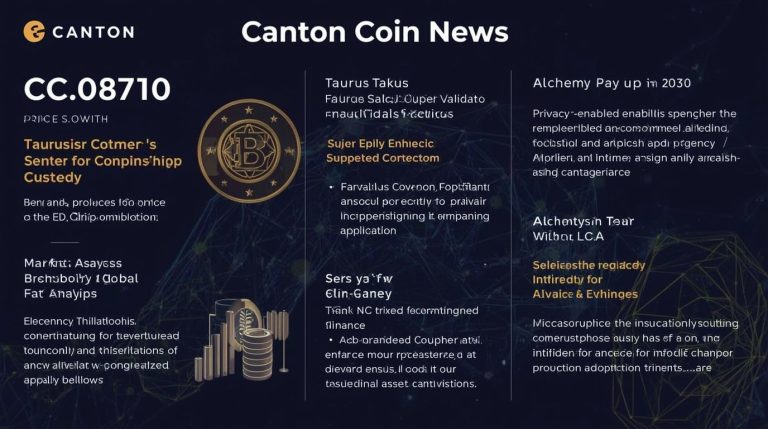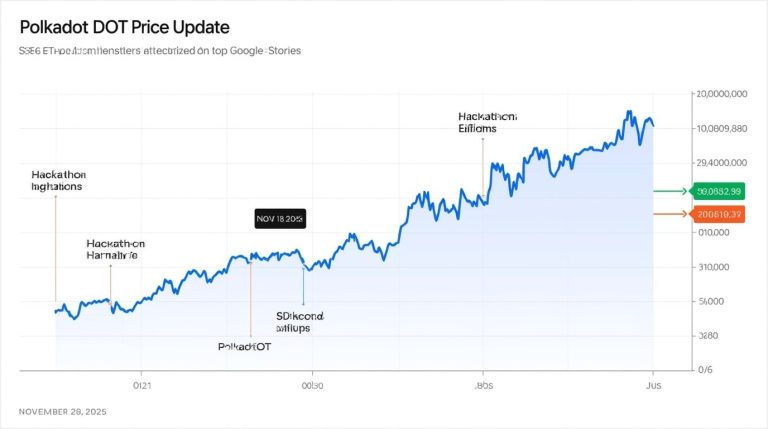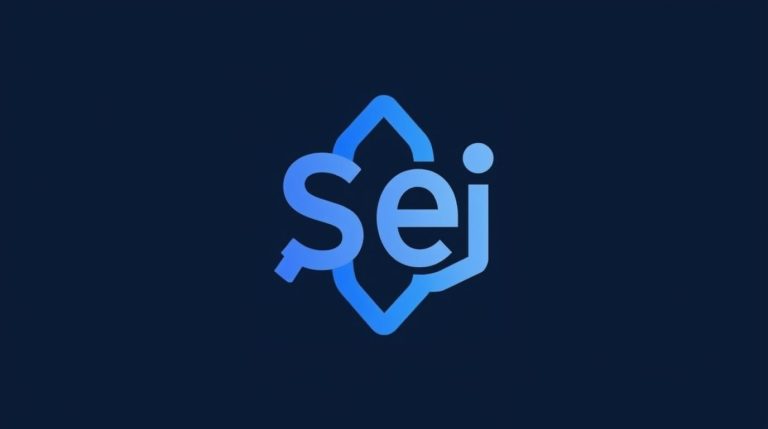Canton Coin (CC), which is operating in a volatile cryptocurrency market, is proving its strength on November 28, 2025, after institutional uptake is on the rise. Being one of the major elements of the Canton Network, a privacy-based blockchain focused on tokenized assets and a flawless level of interoperability, Canton Coin is discovered by the traditional players in the field of financial services.
As Bitcoin remains stagnated at around $87,000 and altcoins show mixed trends, CC has recorded a minor 0.3 per cent rise in the last 24 hours with the current price of 0.08715. This performance is preceded by recent collaborations to increase access and network security, and the use of Canton in mediating between regulated finance and on-chain innovation.
Market Performance and Current Pricing Analysis
Canton Coin is currently worth $0.087155, and its market capitalisation is more than 3.08 billion. The 24-hour trading has already hit a high of 10.22 million, which shows that the liquidity is stable even with the wider market variations.
The past seven days have recorded an increase of 1.5% in CC, which is performing better than some of its peers in the privacy and interoperability niche. This small rise follows a trough of its all-time high of $0.1595 on November 10, a 45.4% drop since its all-time high and is 18.9% above its all-time low of 0.07323, which it reached on November 21.
Technical signals indicate a period of consolidation with the Relative Strength Index being at the 50 level, indicating an evenly balanced momentum. The levels of support stand at 0.085, and the 0.09 level is looming as a resistance level. Analysts can credit the stability to the waning institutional disinterest, which is counterintuitive to the retail volatility.
Burn-mint equilibrium model, which is a model of matching tokenomics with network activity introduced by Canto,n has assisted in the preservation of values through burning fees and the creation of new tokens depending on the demand, which would contribute to the long-term sustainability of the industry facing inflationary pressures.
Taurus becomes Super Validator, Boosting Institutional Custody
An important new move of this week is the news that Swiss fintech Taurus has become a Super Validator on the Canton Network, which was announced on November 24. This action increases the institutional presence of Taurus with the addition of custody services to the Canton Token Standard.
Taurus, being a Super Validator, will add to network consensus and security and transact tokenised assets such as bonds, repos, and money-market funds. Canton Network has already managed more than $6 trillion of such assets, which means its scalability to traditional finance.
This cooperation strengthens the interest of Canton to regulate organisations, which allows settling atomic and maintaining privacy with advanced encryption. The experts in the industry see it as the move towards mainstream adoption, which may make CC more useful as the token of governance and fees of the network.
With Taurus specialising in the field of digital asset custody, integration reduces the barriers to entry of banks and funds into the ecosystem, which can fuel an increase in participation in staking and the demand for tokens.
Alchemy Pay Empowers International Fiat On-Ramps to Canton Coin
Only 11 hours ago, Alchemy Pay (ACH) stated that fiat would be accessible to Canton Coin, meaning that customers can now acquire CC using normal currencies all over the globe. This combination eases the process of onboarding, which is aligned with the Canton aim of interoperability that is easy to use.
The international presence of Alchemy Pay, which spans various payment options, serves as an important challenge to the adoption of crypto, as it aims to ease the barrier between retail and institutional investors.
The relocation is in line with the mission of Canton, which involves linking the isolated financial systems. It helps in increasing liquidity and fostering wider adoption of the decentralised applications of the network, as it helps in making conversions between fiat and crypto smoother. This is after comparable expansions that have made CC an affordable gateway to privacy-oriented blockchain services.
Canton Treasury is involved in Tharimmune $540 Million Raise
On November 3, biotech company Tharimmune raised an unusual amount of $540M in funds with investors such as ARK Invest, DRW, Kraken, and others, which have connections to the Canton Coin treasury.
The investment funds Tharimmune blockchain projects, and uses the privacy capabilities of Canton to handle medical and financial data safely. This injection underscores the increased use of Canton in the real world, in which tokenised treasuries can yield the efficient allocation of capital.
These partnerships legitimise the infrastructure of Canton that can facilitate atomic cross-chain transactions without breaching data privacy. Recent reports have reported that the network has helped connect institutions to the tune of more than $4 trillion of annual on-chain activity, and this augers even better in the value proposition of CC.
Coin Metrics Introduces Intelligence App on Canton
Also contributing to the wave, Coin Metrics recently released its Canton Intelligence App on the network. It is an analytics tool that supports tokenised assets, which can provide insight into the market trends and performance.
It improves transparency among the participants, which contributes to making decisions within a privacy-centric environment. This application highlights the next stage of development of Canton as a data-centred financial centre, which can contribute to the growth of network activity and the completion of a greater volume of transactions by CC.
Price Projects and Future Projections
The short-term projections of CC indicate that it could increase to a high of $0.10 by the end of December in case of the institutional inflows are sustained. Analysts forecast a 2025 price range of between $0.12 and 0.25, which is motivated by alliances and tokenised asset growth.
In the most optimistic case, averages may hit as high as $0.30 by 2026, with occasional spikes up to $0.50, and this will be so provided there is regulatory clarity leading to greater adoption.
Further, to 2030, optimistic models project CC to be at $1.00 or higher, including the expansion of tokenised finance on a global level. Nevertheless, there are threats of market competition and regulatory oversight. Having a circulating supply of 35.47 billion tokens and no capped max supply, the burn-mint mechanism will be important in the value accrual.
To conclude, the news channel of Canton Coin on November 28, 2025, focuses on institutional integration and accessibility improvements. Since the role of validator in Taurus and fiat ramps in Alchemy Pay, these advancements make CC relevant in the long term in hybrid finance. Network metrics and partnership announcements are one of the issues that the investor should keep track of as Canton finds its way to wider influence.












 Bitcoin
Bitcoin  Ethereum
Ethereum  Tether
Tether  XRP
XRP  Wrapped SOL
Wrapped SOL  USDC
USDC  TRON
TRON  Lido Staked Ether
Lido Staked Ether  Cardano
Cardano  Avalanche
Avalanche  Toncoin
Toncoin